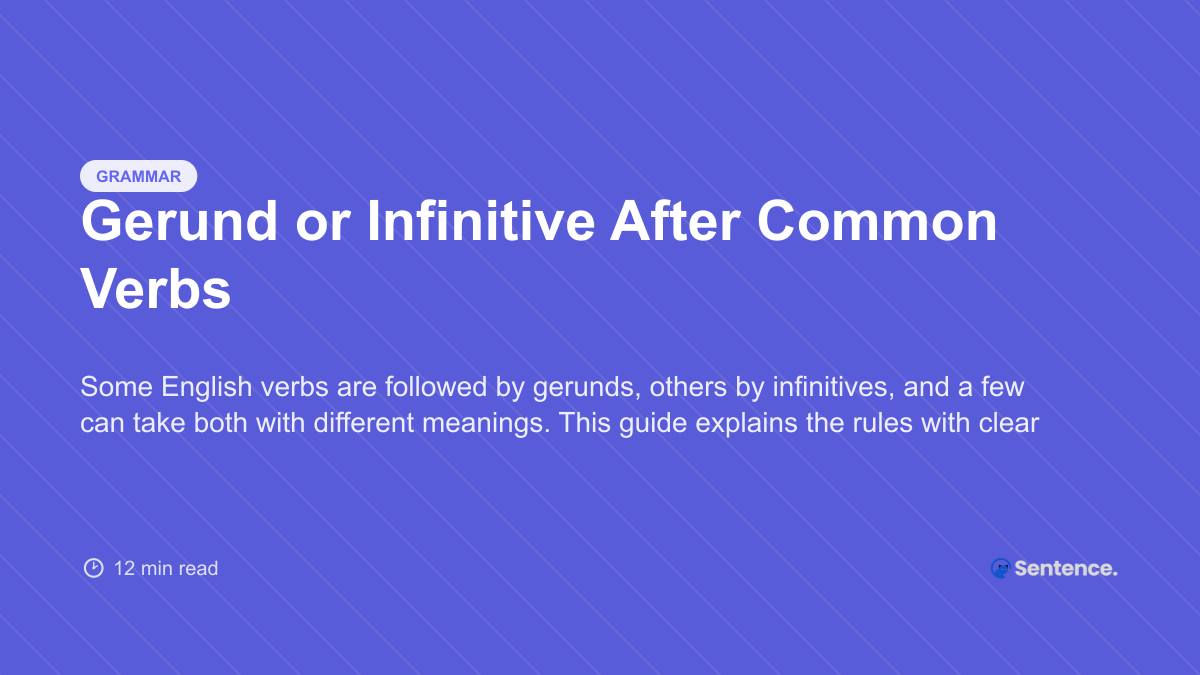
Gerund or Infinitive After Common Verbs
Some English verbs are followed by gerunds, others by infinitives, and a few can take both with different meanings. This guide explains the rules with clear examples, tables, and memory tips.

Some English verbs are followed by gerunds, others by infinitives, and a few can take both with different meanings. This guide explains the rules with clear examples, tables, and memory tips.
One of the trickiest grammar topics for English learners is deciding whether to use a gerund (verb + –ing) or an infinitive (to + verb) after certain verbs. While both forms look simple, choosing the wrong one can completely change the meaning of a sentence — or make it sound unnatural.
The good news is that verbs tend to follow predictable patterns. Once you understand which verbs take gerunds, which take infinitives, and which accept both, you'll be able to form sentences more confidently and naturally.
A gerund acts like a noun in a sentence and is often used after verbs that describe enjoyment, avoidance, or completion. These verbs typically refer to activities or experiences.
Common verbs followed by a gerund include:
The pattern is simple:
verb + –ing
Here are some examples:
| Verb | Gerund Form | Example |
|---|---|---|
| enjoy | enjoy + –ing | I enjoy cooking on weekends. |
| suggest | suggest + –ing | She suggested meeting earlier. |
| avoid | avoid + –ing | They avoided talking about it. |
Think of gerunds as actions you’re actively doing or experiencing.
The infinitive is used after verbs that express intent, desire, decisions, or plans. These verbs point toward something that has not yet happened.
Common verbs followed by an infinitive include:
The pattern is:
verb + to + verb
| Verb | Infinitive Form | Example |
|---|---|---|
| want | want + to + verb | I want to learn Spanish. |
| decide | decide + to + verb | They decided to leave early. |
| hope | hope + to + verb | We hope to visit soon. |
Infinitives feel more future-oriented — something you intend or expect to happen.
Some verbs can be followed by either a gerund or an infinitive with a slight change in meaning. These verbs are often the source of confusion, but once you understand the difference, they become easy to use correctly.
| Verb | Gerund Meaning | Infinitive Meaning | Examples |
|---|---|---|---|
| stop | stop an activity | stop in order to | He stopped smoking. / He stopped to smoke. |
| remember | remember a past action | remember something now so you can act | I remember meeting her. / Remember to call me. |
| try | experiment with methods | attempt to do something difficult | Try adding sugar. / Try to lift this box. |
These distinctions change the meaning, so choose carefully.
Many mistakes come from translation or assuming that verbs behave the same way in every language. English has many fixed patterns, so memorizing common verb groups helps a lot.
Some frequent errors include:
Learning the typical verb patterns is the easiest way to avoid these mistakes.
Quick Memory Guide:
GERUND = enjoyment, avoidance, experience
INFINITIVE = plans, intentions, decisions
Answers: to take / getting / both correct with different meanings / to move
⭐ Pro Tip: When in doubt, check whether the verb describes a plan or an experience — this often reveals the correct form.
Knowing when to use a gerund or an infinitive becomes much easier once you understand the patterns behind common verbs. Gerunds typically follow verbs related to enjoyment or experience, while infinitives usually follow verbs connected to decisions or intentions. Some verbs allow both forms but change meaning, so keep an eye out for those exceptions. With consistent practice, these structures will soon feel natural and automatic in your speaking and writing.